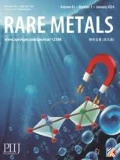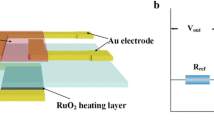Abstract
Porous Zn2TiO4–ZnO microtubes have been successfully fabricated using chemical precipitation followed by a calcination process using a carbon fiber template. The porous Zn2TiO4–ZnO microtubes with a diameter of ~ 4 μm consisted of Zn2TiO4 and ZnO nanoparticles. These displayed worm-like pore structures. Carbon fibers played an important role during the porous Zn2TiO4–ZnO microtube formation process. The porous and hollow structure of Zn2TiO4–ZnO provided abundant active sensing sites and channels for gas adsorption and diffusion. The porous Zn2TiO4–ZnO microtubes exhibited improved gas sensing properties for acetone when compared with pure ZnO. The Zn2TiO4–ZnO sensor response was 33.4 for 100 μg·ml−1 acetone at the optimum operating temperature (370 °C). This was ~ 2.7 times higher than that of pure ZnO. Additionally, the as-prepared porous Zn2TiO4–ZnO microtubes displayed sufficient long-term acetone stability and selectivity. This showed the potential application for acetone detection. The enhanced Zn2TiO4–ZnO gas sensing properties are due to the unique heterogeneous and porous structure, which was analyzed using the porous and band structure.
Graphic abstract









Similar content being viewed by others
References
Fan YY, Tu HL, Pang Y, Wei F, Zhao HB, Yang Y, Ren TL. Au-decorated porous structure grapheme with enhanced sensing performance for low-concentration NO2 decoration. Rare Met. 2020;39(6):651.
Xu Y, Zheng L, Yang C, Zheng W, Liu X, Zhang J. Oxygen vacancies enabled porous SnO2 thin films for highly sensitive detection of triethylamine at room temperature. ACS Appl Mater Interfaces. 2020;12(18):20704.
Xu Y, Zheng W, Liu X, Zhang L, Zheng L, Yang C, Pinna N, Zhang J. Platinum single atoms on tin oxide ultrathin film for extremely sensitive gas detection. Mater Horiz. 2020;7:1519.
Saasa V, Beukes M, Lemmer Y, Mwakikunga B. Blood ketone bodies and breath acetone analysis and their correlations in type 2 diabetes mellitus. Diagnostics. 2019;9(4):224.
Dumrongrojthanath P, Phuruangrat A, Thongtem S, Thongtem T. Photocatalysis of Cd-doped ZnO synthesized with precipitation method. Rare Met. 2019. https://doi.org/10.1007/s12598-019-01283-6.
Ouyang W, Teng F, He J, Fang X. Enhancing the photoelectric performance of photodetectors based on metal oxide semiconductors by charge-carrier engineering. Adv Funct Mater. 2019;29(9):1807672.
Lin T, Zhang X, Huang X, Gong X, Zhang J, Hu X. Microstructure and properties of microarc oxidation coating formed on aluminum alloy with compound additives nano-TiO2 and nano-ZnO. Rare Met. 2018;37(11):976.
Ning Y, Zhang Z, Teng F, Fang X. Novel transparent and self-powered UV photodetector based on crossed ZnO nanofiber array homojunction. Small. 2018;14(13):1703754.
Zhao B, Wang F, Chen H, Zheng L, Su L, Zhao D, Fang X. An ultrahigh responsivity (9.7 mA·W−1) self-powered solar-blind photodetector based on individual ZnO–Ga2O3 heterostructures. Adv. Funct. Mater. 2017;27(17):1700264.
Ouyang W, Teng F, Jiang M, Fang X. ZnO film UV photodetector with enhanced performance: heterojunction with CdMoO4 microplates and the hot electron injection effect of Au nanoparticles. Small. 2017;13(39):1702177.
Hu L, Yan J, Liao M, Xiang H, Gong X, Zhang L, Fang X. An optimized ultraviolet-a light photodetector with wide-range photoresponse based on ZnS/ZnO biaxial nanobelt. Adv Mater. 2012;24(17):2305.
Jiang Z, Zhu K, Lin Z, Jin S, Li G. Structure and Raman scattering of Mg-doped ZnO nanoparticles prepared by sol–gel method. Rare Met. 2018;37(10):881.
Agarwal S, Rai P, Gatell EN, Llobet E, Gvell F, Kumar M, Awasthi K. Gas sensing properties of ZnO nanostructures (flowers/rods) synthesized by hydrothermal method. Sens Actuators B. 2019;292(1):24.
Ganesh RS, Patil VL, Durgadevi E, Navaneethan M, Ponnusamy S, Muthamizhchelvan C, Kawasaki S, Patil PS, Hayakawa Y. Growth of Fe doped ZnO nanoellipsoids for selective NO2 gas sensing application. Chem Phys Lett. 2019;734:136725.
Liu F, Huang G, Wang X, Xie X, Xu G, Lu G, He X, Tian J, Cui H. High response and selectivity of single crystalline ZnO nanorods modified by In2O3 nanoparticles for n-butanol gas sensing. Sens Actuators B. 2018;277(20):144.
Sun J, Wei Q, Song P, Yang Z, Wang Q. Porous ZnO cubes derived from metal-organic frameworks with excellent sensing performance triethylamine. J Mater Sci Mater Electron. 2020;31(1):838.
Ridha NJ, Alosfur FKM, Jumali MHH, Radiman S. Effect of Al thickness on the structural and ethanol vapor sensing performance of ZnO porous nanostructures prepared by microwave-assisted hydrothermal method. Nanotechnology. 2020;31(14):145502.
Song L, Yue H, Li H, Liu L, Li Y, Du L, Duan H, Klyui NI. Hierarchical porous ZnO microflowers with ultra-high ethanol gas-sensing at low concentration. Chem Phys Lett. 2018;699:1.
Liu F, Wang X, Chen X, Song X, Tian J, Cui H. Porous ZnO ultrathin nanosheets with high specific surface areas and abundant oxygen vacancies for acetylacetone gas sensing. ACS Appl Mater Interfaces. 2019;11(27):24757.
Zhang D, Jin Y, Cao Y. Facile synthesis and ammonia gas sensing properties of NiO nanoparticles decorated MoS2 nanosheets heterostructure. J Mater Sci Mater Electron. 2019;30(1):573.
Ramos RA Jr, Boratto MH, Scalvi LVA. On the photo-induced electrical conduction related to gas sensing of the Sb:SnO2/TiO2 heterostructure. Sensor Actuat A Phys. 2018;281(1):250.
Xu Y, Zheng L, Yang C, Zheng W, Liu X, Zhang J. Chemiresistive sensors based on core-shell ZnO@TiO2 nanorods designed by atomic layer deposition for n-butanol detection. Sens Actuators B. 2020;310(1):127846.
Sett A, Dey S, Guha PK, Bhattacharyya TK. ZnO/γ-Fe2O3 heterostructure toward high-performance acetone sensing. IEEE Sens J. 2019;19(19):8576.
Zhang Q, Xie G, Xu M, Su Y, Tai H, Du H, Jiang Y. Visible light-assisted room temperature gas sensing with ZnO–Ag heterostructure nanoparticles. Sens Actuators B. 2018;259(15):269.
Liu F, Chen X, Wang X, Han Y, Song X, Tian J, He X, Cui H. Fabrication of 1D Zn2SnO4 nanowire and 2D ZnO nanosheet hybrid hierarchical structures for use in triethylamine gas sensors. Sens Actuators B. 2019;291(15):155.
Liu Y, Li L, Yu H, Cui T, Xu D. Investigation of the magnetic properties of Zn2TiO4 single crystal. J Magn. 2019;24(3):512.
Xiao L, Zeng L, Yang X. Electronic and optical properties of spinel Zn2TiO4 under pressure effect: ab initio study. Eur Phys J B. 2019;92(8):182.
Chai Y, Li L, Lu J, Li D, Shen J, Zhang Y, Liang J, Wang X. Germanium-substituted Zn2TiO4 solid solution photocatalyst for conversion of CO2 into fuels. J Catal. 2019;371:144.
Manchala S, Nagappagari LR, Venkatakrishnan SM, Shanker V. Facile synthesis of noble-metal free polygonal Zn2TiO4 nanostructures for highly efficient photocatalytic hydrogen evolution under solar light irradiation. Int J Hydrog Energy. 2018;43(29):13145.
Zhao D, Zhou Y, Xiang Y, Deng Y, Zhang Y, Zhao Z, Zeng D. A novel self-growing nanosheets/dumbbell-shape ZnO structure: facilitating charge generation and separation. J Mater Sci Mater Electron. 2018;29(23):19805.
Hsiao CY, Wu JC, Shih CF. Epitaxy of Zn2TiO4 (111) thin films on GaN (001). Mater Res Bull. 2013;48(3):1316.
Lim HS, Lee JS, Lee S, Kang YS, Sun YK, Suh KD. Walnut-like ZnO@Zn2TiO4 multicore-shell submicron spheres with a thin carbon layer: fine synthesis, facile structural control and solar light photocatalytic application. Acta Mater. 2017;122(1):287.
Reddy IN, Reddy CV, Shim J, Akkinepally B, Cho M, Yoo K, Kim D. Excellent visible-light driven photocatalyst of (Al, Ni) co-doped ZnO structures for organic dye degradation. Catal Today. 2020;340(15):277.
Kim HW, Kwon YJ, Mirzaei A, Kang SY, Choi MS, Bang JH, Kim SK. Synthesis of zinc oxide semiconductors-graphene nanocomposites by microwave irradiation for application to gas sensors. Sens Actuators B. 2017;249:590.
Chen Y, Liu B, Liu J, Pei C, Zhao H, Shang Y, Yang H. Enhancing gas-sensing property and sensing mechanism at molecule level of the hollow microspheres assembled with ZnO nanoflakes exposing 001 facets. J Mater Sci Mater Electron. 2020;31(3):6118.
Yang M, Lu Z, Wang X, Zhang H, Chen F, Sun J, Yang J, Sun Y, Lu G. Acetone sensors with high stability to humidity changes based on Ru-doped NiO flower-like microspheres. Sens Actuators B. 2020;313:127965.
Al-Hadeethi Y, Umar A, Ibrahim AA, Al-Heniti SH, Kumar R, Baskoutas S, Raffah BM. Synthesis, characterization and acetone gas sensing applications of Ag-doped ZnO nanoneedles. Ceram Int. 2017;43(9):6765.
Jiang L, Tu S, Yu H, Meng Y, Zhao Y, Hou X. Gas sensitivity of heterojunction TiO2NT/GO materials prepared by a simple method with low-concentration acetone. Ceram Int. 2020;46:5437.
Zhang H, Cen Y, Du Y, Ruan S. Enhanced acetone sensing characteristics of ZnO/graphene composites. Sensors. 2016;16(11):1876.
Cao E, Song G, Guo Z, Zhang Y, Hao W, Sun L, Nie Z. Acetone sensing characteristics of Fe2O3/In2O3 nanocomposite. Mater Lett. 2020;261:126985.
Liu C, Wang B, Liu T, Sun P, Gao Y, Liu F, Lu G. Facile synthesis and gas sensing properties of the flower-like NiO-decorated ZnO microstructures. Sens Actuators B. 2016;235(1):294.
Zhang R, Zhang T, Zhou T, Lou Z, Deng J, Wang L. Fast and real-time acetone gas sensor using hybrid ZnFe2O4/ZnO hollow spheres. RSC Adv. 2016;6(71):66738.
Al-Hadeethi Y, Umar A, Al-Heniti SH, Kumar R, Kim SH, Zhang X, Raffah BM. 2D Sn-doped ZnO ultrathin nanosheet networks for enhanced acetone gas sensing application. Ceram Int. 2017;43(2):2418.
Kavitha G, Arul KT, Babu P. Enhanced acetone gas sensing behavior of n-ZnO/p-NiO nanostructures. J Mater Sci Mater Electron. 2018;29(8):6666.
Bhati VS, Hojamberdiev M, Kumar M. Enhanced sensing performance of ZnO nanostructures-based gas sensors: a review. Energy Rep. 2020;6:46.
Wang P, Dong T, Jia C, Yang P. Ultraselective acetone-gas sensor based ZnO flowers functionalized by Au nanoparticle loading on certain facet. Sens Actuators B. 2019;288(1):1.
Liu X, Zhang J, Wang L, Yang T, Guo X, Wu S, Wang S. 3D hierarchically porous ZnO structures and their functionalization by Au nanoparticles for gas sensors. J Mater Chem. 2011;21(2):349.
Acknowledgements
This work was financially supported by the Distinguished Taishan Scholars in Climbing Plan (No. tspd20161006), Shandong Provincial Natural Science Foundation (No. ZR2019MEM049), the National Natural Science Foundation of China (Nos. 51772176 and 51971121) and Shandong Province Key Laboratory of Mine Mechanical Engineering (No. 2019KLMM101).
Author information
Authors and Affiliations
Corresponding author
Electronic supplementary material
Below is the link to the electronic supplementary material.
Rights and permissions
About this article
Cite this article
Chen, XY., Wang, XZ., Liu, FJ. et al. Fabrication of porous Zn2TiO4–ZnO microtubes and analysis of their acetone gas sensing properties. Rare Met. 40, 1528–1535 (2021). https://doi.org/10.1007/s12598-020-01518-x
Received:
Revised:
Accepted:
Published:
Issue Date:
DOI: https://doi.org/10.1007/s12598-020-01518-x




